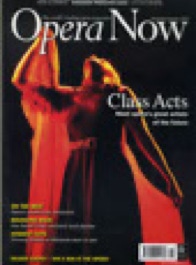Puccini Tosca Opera Holland Park, July 2008 Director Stephen Barlow Lighting Peter Mumford
The production was also presented at the Richmond Theatre in February 2009
Reviews
How do you stage Tosca’s final leap of death on a small stage? By a stroke of genius, that’s how. ... a thrilling and astonishing production... (Metro)
... an endlessly inventive production, witty and moving... The detail was staggering... (Opera Now magazine)
Opera Now magazine cover November 2008
